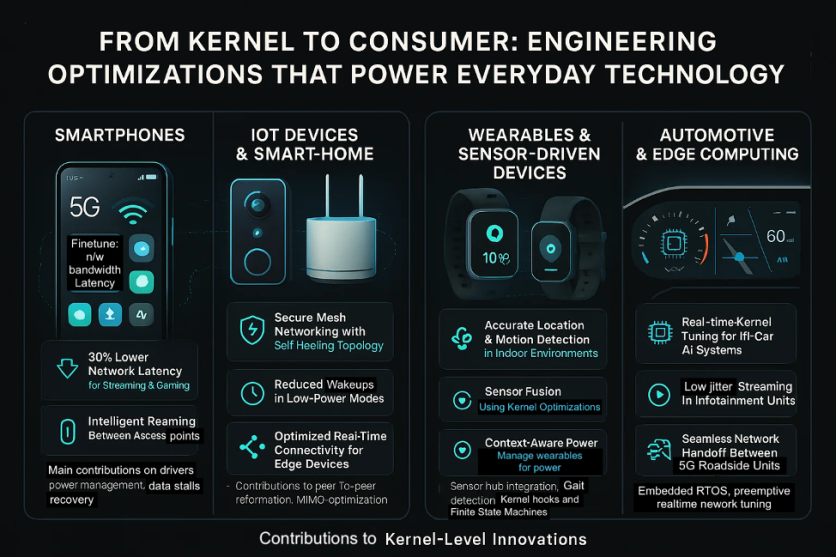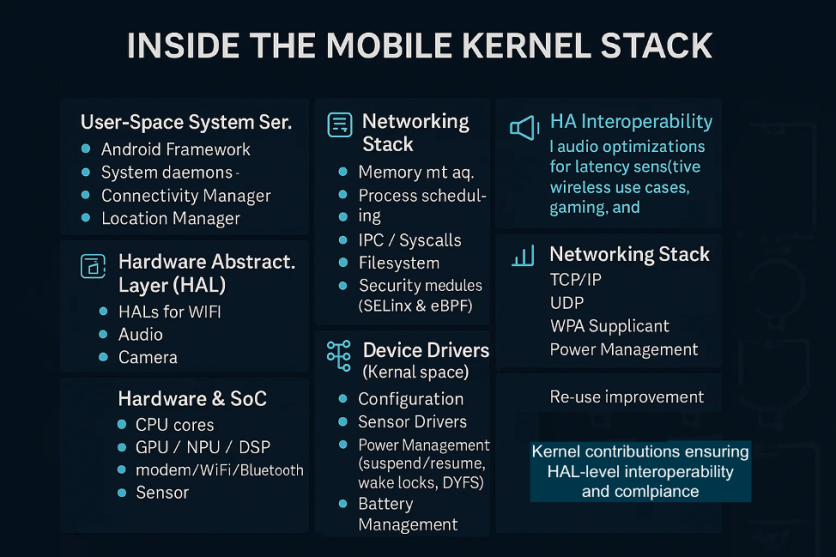
Mobile and embedded systems are the hidden workhorses of modern technology—from the smartphones in our pockets to IoT devices in our homes and industries. At the heart of these systems lies the operating system kernel, which manages hardware resources and enables features such as wireless connectivity, sensors, and real-time processing.
Open-source kernel engineering (exemplified by projects like the Linux kernel) has been a driving force in this domain, allowing developers worldwide to improve software that runs on billions of devices collaboratively. For instance, Android, which uses the Linux kernel, is now the most widely used operating system across computing devices.
This broad adoption means innovations and fixes in open-source kernels can ripple out to countless products, fostering faster development of new capabilities in mobile and embedded tech.
As an active contributor to open-source projects, he has worked on low-level software—from device drivers and hardware abstraction layers (HALs) to wireless stack optimizations—that directly impact how well devices perform. His expertise spans kernel internals and real-time systems to emerging wireless standards, making him a respected voice in the community.
The Path into Kernel Engineering and Embedded Systems
Mobile phones, smart appliances, and automotive systems all rely on kernels that manage hardware resources efficiently. Many developers begin their kernel engineering journey by exploring open-source projects like the Linux kernel. In this arena, they see firsthand how small. Patches can scale globally and enhance entire product lines.
Sudhir emphasizes that a low-level perspective reveals the significant impact kernel optimizations have on security and performance. In his words, "Working on embedded systems and mobile devices exposed me to the intricacies of operating systems and the immense value that kernel-level optimizations bring to performance, security, and efficiency."
He found that real-world experiences with hardware and upstream patches were the best way to refine his skill set in embedded systems. This approach led him to professional roles where he tackled tasks like driver development and standard compliance checks.
Reflecting on the broader implications of open source, he says, "I made nearly 900 kernel commits, enhancing wireless connectivity, security, and power management for mobile devices used worldwide." Such widespread adoption illustrates how a single engineer's work can dramatically influence the global ecosystem of connected devices.
Open-Source Contributions and Their Impact
Contributions in open-source repositories often start as incremental patches or bug fixes but can evolve into major enhancements that unlock new functionality. Sudhir has devoted significant attention to wireless networking, optimizing portions of the Linux networking stack and drivers.
By improving throughput and reducing power consumption, his code helps devices maintain stable connections under diverse operating conditions. According to him, "I implemented power-efficient connectivity algorithms, extending battery life for mobile devices."
These changes are pivotal because mobile devices frequently rely on advanced kernel features to handle concurrency, memory management, and security tasks in real-time. In addition, he has explored the integration of hardware-specific code for components like Qualcomm MSM chipsets.
Kernel Engineering Driving Mobile and Embedded Innovation

Engineers in kernel development often grapple with optimizing power consumption, real-time responsiveness, and hardware abstraction. Balancing performance with power efficiency can be especially difficult in resource-constrained devices that still need robust features. The debugging process also becomes more complex at the kernel level due to limited user-space tools.
Reflecting on these hurdles, Sudhir points out, "Kernel debugging is inherently challenging due to the lack of direct user-space tools, necessitating the use of techniques such as JTAG debugging, printk logging, dmesg and ftrace."
In addition, developers must maintain upstream compatibility, so their patches are not lost when the community updates its code base. Complexities arise from dealing with vendor-specific hardware abstraction layers that must integrate smoothly into the kernel's modular design.
"Maintaining upstream compatibility involves keeping patches aligned with upstream kernel changes to avoid breakage when vendors update their device trees and drivers," he emphasizes, noting that this proactive approach ensures long-term benefits for everyone using the Linux kernel.
Advancing Wireless Capabilities in Devices
Wireless connectivity underpins the modern mobile and IoT ecosystem, making kernel-level optimizations for Wi-Fi, Bluetooth, and cellular networks increasingly vital. Sudhir's work focuses on reducing latency, power consumption, and data stalls in real-time streaming use cases such as video conferencing or automotive infotainment systems.
Notably, his solutions also target security and overall device interoperability. He has contributed to multiple enhancements in MIMO-based optimizations and managed to reduce wakeups in low-power modes. "These solutions have been widely adopted by chipset vendors and integrated into flagship mobile devices, IoT, and embedded systems," he says, highlighting how targeted fixes at the driver and firmware levels have ripple effects on consumer tech, industrial machinery, and emerging IoT platforms.
Role of Hardware Abstraction Layers (HAL)

The open-source kernel community relies on maintainers, mailing lists, and continuous review processes to ensure patches are both efficient and stable. Developers often discuss proposals on public forums, refine code collaboratively, and iterate based on feedback from peers.
Sudhir stresses the importance of clarity and adherence to common standards, stating, "Maintaining code quality and adherence to standards involves following strict coding guidelines (e.g., the Linux kernel coding style) and ensuring that patches are modular, reusable, and do not break existing functionality."
He also underscores the value of good documentation and communication for driving consensus among geographically distributed teams. Having to handle asynchronous interactions across time zones, developers benefit from incremental patch submissions.
"Respond promptly to code review feedback and iterat quickly," he adds, highlighting that establishing trust and maintaining productive relationships with community maintainers accelerate the acceptance of important changes.
Overcoming Development Challenges Through Open Collaboration
Embedded and real-time applications are advancing due to improvements in hardware performance, evolving wireless standards, and new demands such as on-device machine learning. The Linux kernel is increasingly gaining real-time capabilities (such as fully merged PREEMPT_RT patches) and advanced scheduling features to manage concurrency. Additionally, 5G and next-gen wireless protocols require tight integration with kernel subsystems to maintain low latency. Sudhir notes, "5G and next-gen wireless innovations are characterized by enhanced edge computing capabilities with ultra-low-latency networking, as well as the integration of new MIMO and beamforming algorithms into open-source kernel code."
Security considerations are also growing, requiring hardware-backed enclaves and zero-trust models at the kernel level for IoT and edge devices. Sudhir sees a movement toward energy-efficient designs that optimize real-time processing for mission-critical tasks. "These trends will reshape the landscape of embedded computing over the next decade," he says, highlighting how kernel engineers must adapt to accommodate future breakthroughs in AI and connectivity.
Real-Time Systems and Next-Gen Technologies
Becoming an active contributor in large kernel communities can be daunting, especially for newcomers unsure of best practices. Sudhir believes in an incremental approach, urging developers to start with small bug fixes or documentation updates.
This initial step familiarizes them with the community, coding standards, and review processes. He advises, "Attend open-source conferences and kernel summits, and be open to criticism while iterating on patches based on maintainer feedback."
Patience and persistence also play major roles. Patches often go through multiple review rounds, and rejections are not uncommon. Over time, consistent engagement and a willingness to learn from experienced maintainers can help build trust.
Advice for Aspiring Kernel Engineers and Innovators
As technology continues evolving, kernel engineers are constantly faced with emerging opportunities. Sudhir points to areas like next-generation wireless standards (such as WiFi 7) and quantum-safe cryptography, where new protocols and security models require kernel-level changes.
By integrating these capabilities early, open-source projects remain on the cutting edge. He remarks, "Next-generation wireless standards, such as 6G and WiFi 7, along with the general use of LLMs in AI for quantum edge computing, are driving transformative changes in the industry."
Engineers must also navigate how AI influences operating systems, including machine learning-assisted optimizations for scheduling and resource management. Sudhir sees these developments shaping the next decade of connected devices, prompting deeper collaboration between software and hardware teams.
"These areas represent high-impact innovations that will shape the next decade of computing," he concludes, illustrating how pushing kernel boundaries directly fosters breakthroughs across industries, from consumer electronics to highly specialized embedded applications.
Overall, Sudhir's extensive contributions in wireless optimization, device drivers, and real-time kernel engineering underscore the transformative power of open-source collaboration. By addressing fundamental performance and security challenges at the kernel level, he has helped shape the way modern mobile and embedded systems operate, setting the stage for ever more advanced capabilities in connectivity, AI, and beyond. As embedded systems become more intelligent and interconnected, Sudhir Vissa's work continues to shape the backbone of global innovation—one kernel commit at a time.
ⓒ 2025 TECHTIMES.com All rights reserved. Do not reproduce without permission.





